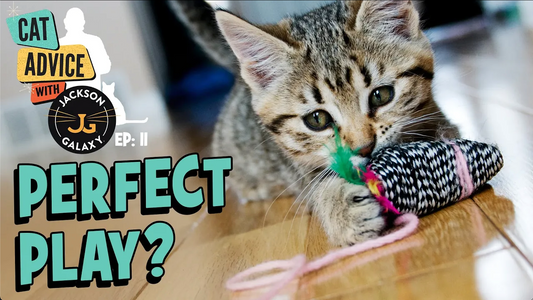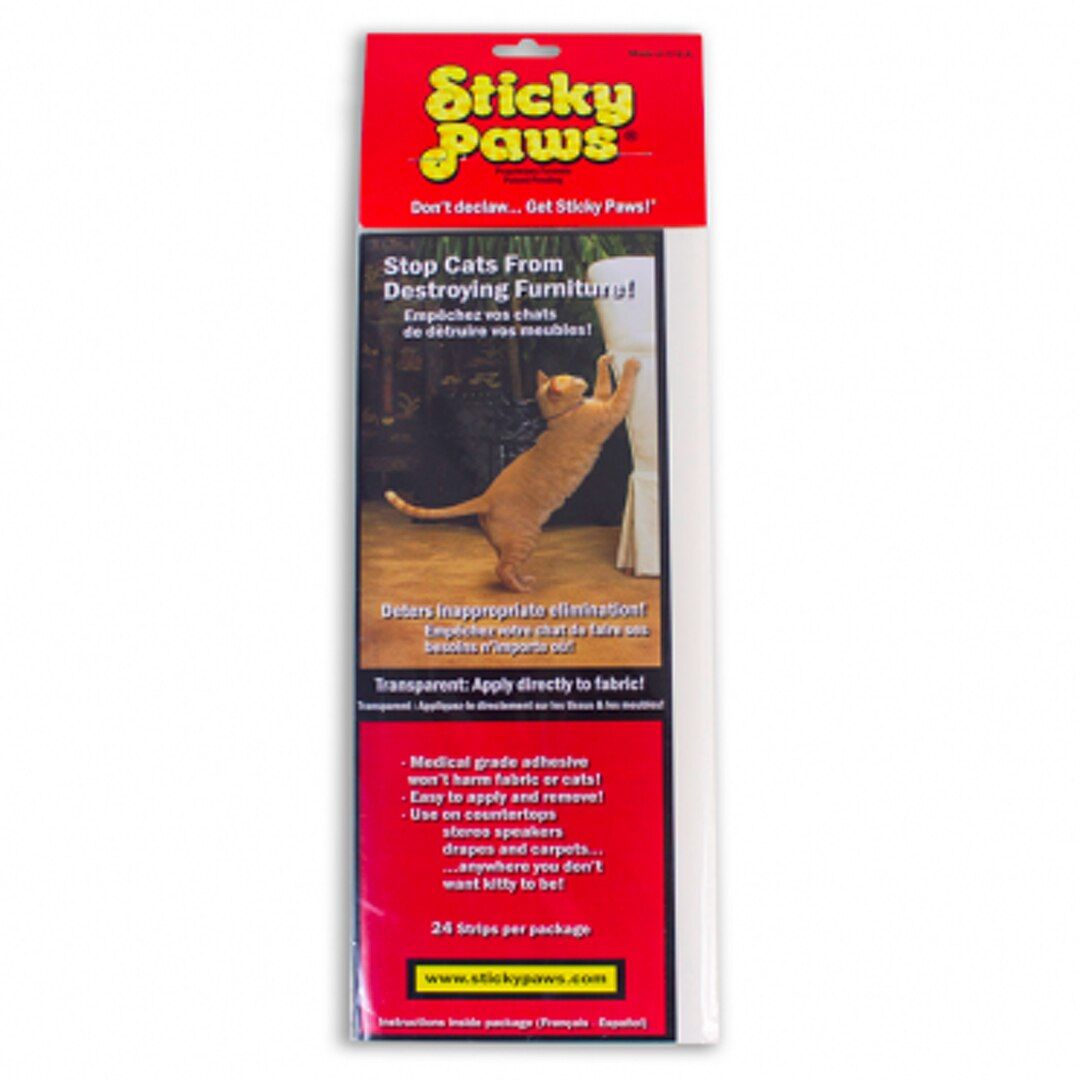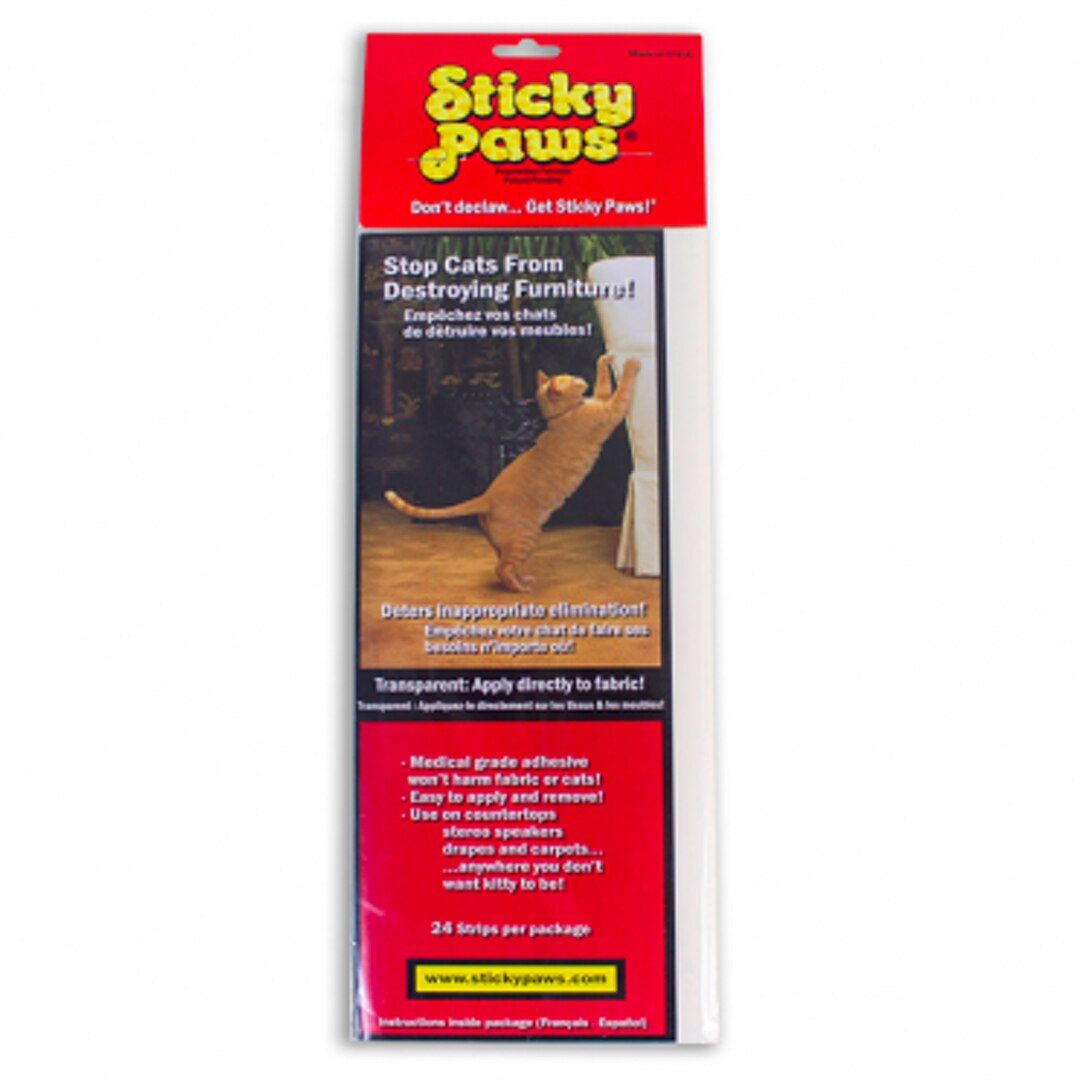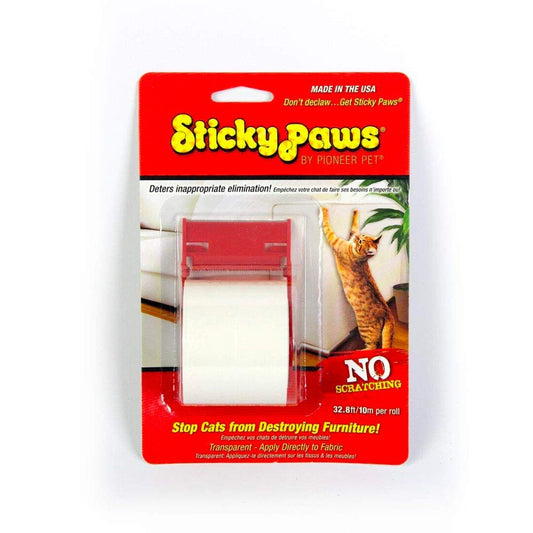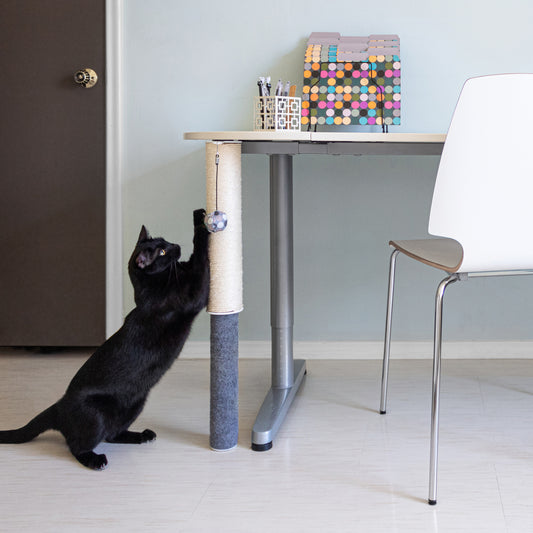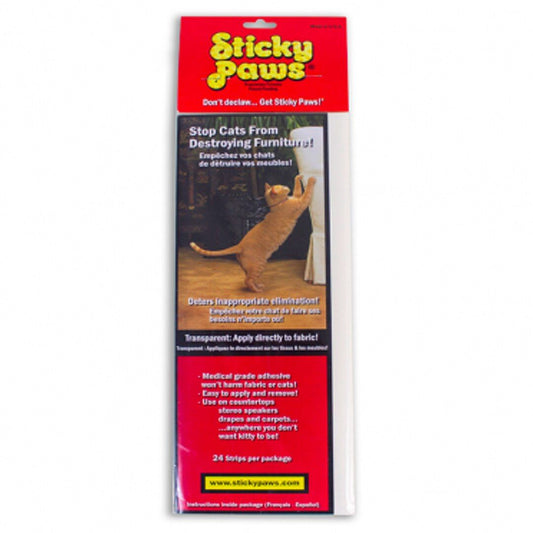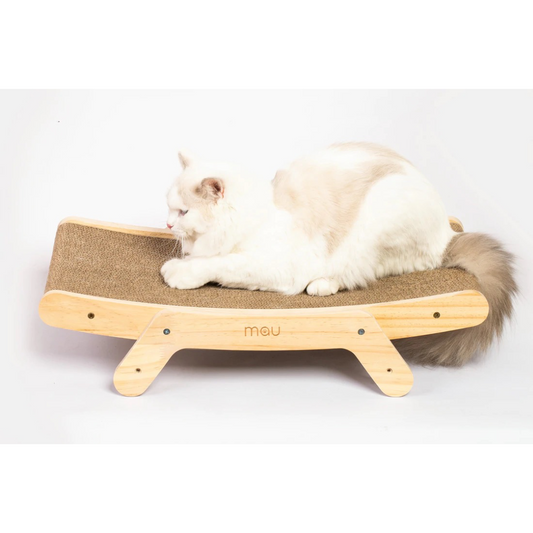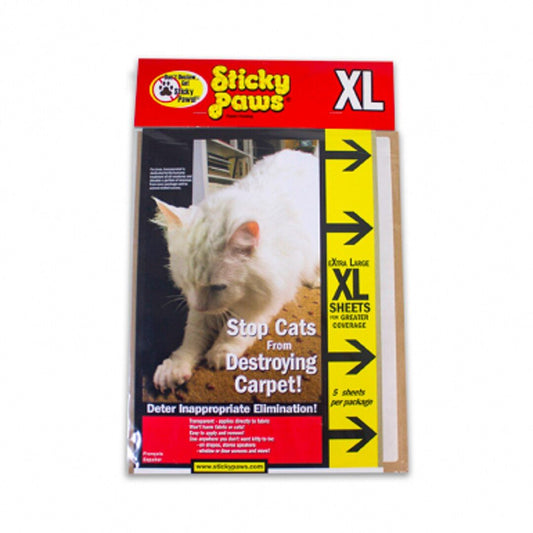Why Having Claws and Scratching is Important to Cats
Claws are a physically, socially, and emotionally vital part of every cat. Scratching, for a cat, is not only a natural act, but a necessary one as well.
- It removes the dead outer sheaths of nail, keeping it sharp and ready for action.
- It is an essential exercise technique which serves to stretch and strengthen their upper bodies.
- Cats mark their territory visually, especially in multi–cat households, as a way of determining rank.
- Between your cat’s toes are scent glands which leave her “signature” when she scratches.
You Should Never Declaw Your Cat!
Declawing is surgery where the claw and end bone of each toe are amputated; it is essentially the amputation of 1/3 of the cat’s paws. Declawed cats must be kept indoors only, since the front claws are a cat’s primary means of self-defense and escape against the many dangers and predators in our area. Declawed cats are often chronically painful, and may develop aggression or litter box problems. We strongly discourage declawing or tendonectomy surgeries.
Paws and claws are integral tools for cats in no uncertain physical and behavioral terms. We have seen many cats relinquished to shelters who were declawed and then developed new unwanted behaviors afterward, including urinating outside the litterbox (usually on carpets, bedding, and furniture), or increased aggression and biting. The Humane Society of Boulder Valley, Denver Dumb Friends League, and many other shelters nationwide condemn declawing, which is considered cruel and/or illegal in many other nations (note, since this article was written Los Angeles, San Francisco, Santa Monica, Berkeley, Beverly Hills, Culver City, West Hollywood and Burbank have banned declawing).
If you have adopted or rescued a declawed cat, you can help heal the physical and psychological trauma of surgery with Declaw Solution from Jackson Galaxy Solutions.
How To Keep Your Cat From Scratching Your Home Furniture
The “Yes” Technique
Appropriate places for your cat to let out his scratching instincts are critical for long term behavioral success. We recommend not only a scratching post, but several, depending on how many areas he likes to scratch on already. For instance if he goes for both arms of the couch, then that’s where you will want your posts at the start.
Cat Furniture: Cat Condos, Scratchers, & Trees
Cat “condos” or “trees” are beneficial in many ways, one of which is to provide a common marking post in multi–cat households. Before you invest a lot of money in buying or building a post, make sure you are catering to your feline friend’s particular preferences. There are inexpensive horizontal cardboard scratchers for carpet–lovers, wedge shaped cardboard ramps for cats who scratch low on furniture, and upright posts or “trees” for cats who like that full–body hang–from–the–claws feeling. The material that the post is made of is also important. Many cats prefer the feel of a sisal rope–wound post, and natural wood is also desirable in that it closely mimics what they’d like to scratch most of all — a tree! A redwood or cedar (softwood) plank or log may be a real hit. Beware of carpet covered furniture, mainly because it’s hard to teach your cat that scratching “this” carpet is okay, but “that” carpet isn’t.
Once the new piece of cat furniture is in your home, rub it with catnip, or dangle your cat’s favorite toy from the top, creating a game which encourages your cat to mimic the motion of scratching. Your lavish praise will also help create a positive association with the act of scratching the cat furniture.
Test Drive the new cat furniture. Remember that in order to fully exercise his upper extremities and get a good stretch, the cat must have enough confidence in the post to put all of his body weight into it. If the post has too small or too insecure a base, it will wobble or tip as he pulls, eroding his confidence in the post and leading him back to that nice solid furniture.
The “No” Technique
We get it. You want your cat to stop scratching apart anything and everything it can get its claws into. So we pulled together a list of some preventative home remedies to help break the cat of the habit of scratching inappropriate objects (your furniture) and keep it that way. The trick is to remove the pleasurable component and replace the action with something not quite so nice.
- Covering up the spot with tin foil
- Placing a double-sided tape like Sticky Paws on the area. We love this tape because it comes in different sizes and versions designed specifically for furniture or plants
- Using a non-sticky, clear plastic protector for your cat’s nails like Purrfect Paw
- Setting up a vinyl carpet runner with the spike side up in front of the spot where they love to scratch

But remember, aversive methods will only work when the cat is provided with an alternate surface that is equally or more desirable.
If you catch the cat in the act of scratching in the undesired spot, even with the aversives in place, correct the cat with a sound; hissing, a quick “ah!” but nothing that she can interpret as punishing sounds associated with your voice. This is why we don’t use the cat’s name during the correction, but only when he performs an action we approve of. His name is only used in conjunction with praise. Especially at first, it’s important to follow the correction with a trip to the post, where the cat has an opportunity to earn praise and again make positive connections with the experience of scratching in the right place. After the correction, carrying the cat over to the right place shouldn’t have a punishing feel to it — don’t scoop the cat off the ground in a sudden motion, or continue after the correction sound with further disapproving tones.
If the cat is having a hard time accepting the post, try daily sessions where you make the sound with your fingers of scratching on the post, accompanied by praise, and an irresistible treat to reward the cat as soon as he performs the desired action. Timing is important! The positives need to be heaped on the cat while he performs the action; a nanosecond later and he’ll have no idea why you are praising him. He’ll like it, but he won’t get the message.
Be patient; incorporating this new behavior into his routine may take a few months without having any “slips”.
How to Trim Your Cat’s Nails
Clipping nails should be done every 2-3 weeks.
Start young: It is easier to start kittens on the right path than to retrain an adult cat, but even older cats can learn to enjoy having their feet handled and to accept nail trimming.
Go slow: Paws are one of the most sensitive parts of a cat’s body. They will often pull away from you and make the job more difficult. If your cat is sensitive, try warming them up to the concept during petting sessions. When the cat is most relaxed, touch one of her paws. Then, gently push on their pads, extending a claw, gently praising the whole time. Respect when she’s had enough, and that’s all for that particular session. A minute or two is a good chunk of time. When your cat is accepting of that feeling, then try clipping. One or two nails per session is fine, at first, getting them used to the sensation while having a positive connection with your praise and gentle touch and perhaps a treat afterward.
Catch ‘em napping: You can often clip a nail or two or three on a sleeping cat with no stress whatsoever. Be gentle and quiet. If he wakes up and pulls away, that’s okay — remember, cats take many naps every day. You’ll have another chance soon! You can also use the same holistic formula that Jackson’s office cat, Mojo, uses, to keep him calmer during nail trims. Stress Stopper can help to reduce any animals’ stress (it’s formulated for all species, not just cats) during short duration disruptions like nail trims, the vacuum cleaner, or house visitors.
Just cut the tips: The sharp end of the nail is the part that can puncture furniture and give leverage to cause damage. In most cats, when the nails are extended you can easily see the clear part and the pink part. All you need to clip is the end of the clear part. When starting out, it is better to err on the side of caution, especially with dark-colored nails where the quick is not obvious. Just one time pressuring, crushing, or cutting the tender part of the claw will cause discomfort or even bleeding, and will seriously set back your efforts at making the clipping process part of your cat’s accepted routine.
Make sure your trimmers are sharp. Dull trimmers will crush and splinter the nail. Blade replacements are available for guillotine (Resco) type trimmers.
If Trimming Your Cat’s Nails is a Challenge Try One of the Below Solutions:
Sticky Paws is sort of like huge, double sided Scotch tape, but the glue is designed to be safe for the furniture. It makes the surface unpleasant for the cat’s feet to touch, and they quickly learn to stay away.
Soft Claws/Soft Paws is a product that has helped many cats who won’t use acceptable scratching outlets. They are basically nail caps that are put on by your veterinarian or groomer at first, but most people can learn to install them themselves. The only drawback to these is that they will get pushed off by new nail growth after several weeks, and need to be replaced, which can become costly if you are not able to clip the claw back and replace the cap yourself. It is, however, a much more humane “last resort” than the following:
Please remember that the commitment to become a cat guardian means working with unwanted behavior to achieve a better relationship and deeper bond with your cat, to make the effort to replace negative habits with positive associations, and ultimately increase your cat’s confidence so she can be a happy and loving companion for life.
The text of this post was written by Jackson and Holistic Veterinarian Dr. Jean Hofve.
Hint: for more on related topics, see



